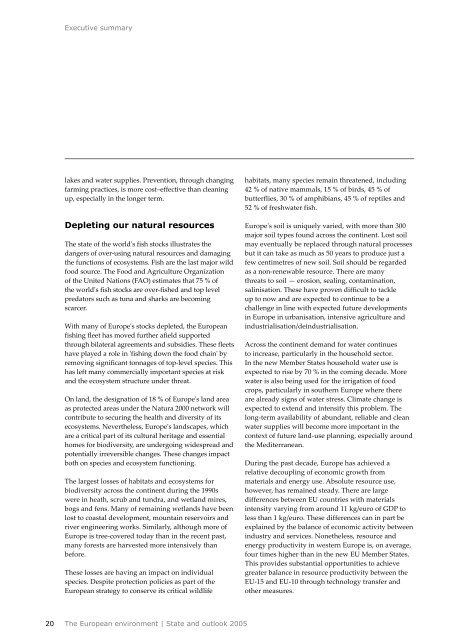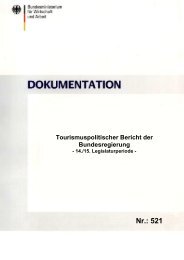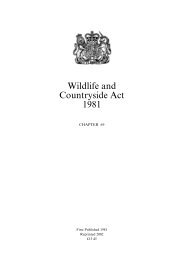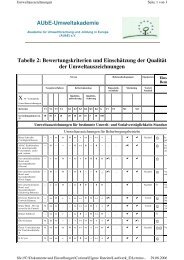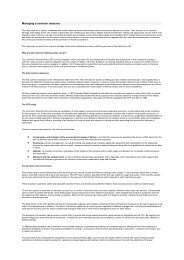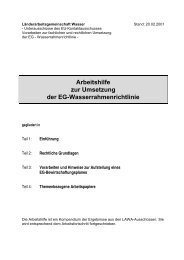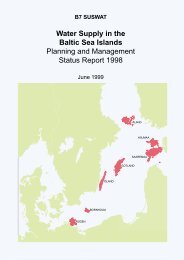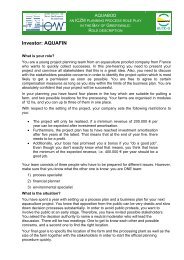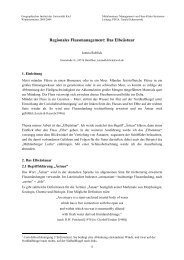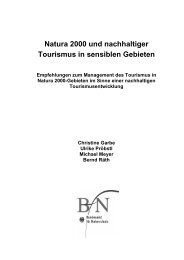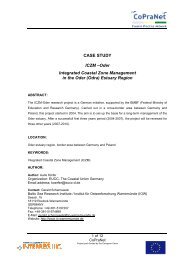The European environment - State and outlook ... - IKZM-D Lernen
The European environment - State and outlook ... - IKZM-D Lernen
The European environment - State and outlook ... - IKZM-D Lernen
Create successful ePaper yourself
Turn your PDF publications into a flip-book with our unique Google optimized e-Paper software.
Executive summary<br />
lakes <strong>and</strong> water supplies. Prevention, through changing<br />
farming practices, is more cost–effective than cleaning<br />
up, especially in the longer term.<br />
Depleting our natural resources<br />
<strong>The</strong> state of the world's fish stocks illustrates the<br />
dangers of over-using natural resources <strong>and</strong> damaging<br />
the functions of ecosystems. Fish are the last major wild<br />
food source. <strong>The</strong> Food <strong>and</strong> Agriculture Organization<br />
of the United Nations (FAO) estimates that 75 % of<br />
the world's fish stocks are over-fished <strong>and</strong> top level<br />
predators such as tuna <strong>and</strong> sharks are becoming<br />
scarcer.<br />
With many of Europe's stocks depleted, the <strong>European</strong><br />
fishing fleet has moved further afield supported<br />
through bilateral agreements <strong>and</strong> subsidies. <strong>The</strong>se fleets<br />
have played a role in 'fishing down the food chain' by<br />
removing significant tonnages of top-level species. This<br />
has left many commercially important species at risk<br />
<strong>and</strong> the ecosystem structure under threat.<br />
On l<strong>and</strong>, the designation of 18 % of Europe's l<strong>and</strong> area<br />
as protected areas under the Natura 2000 network will<br />
contribute to securing the health <strong>and</strong> diversity of its<br />
ecosystems. Nevertheless, Europe's l<strong>and</strong>scapes, which<br />
are a critical part of its cultural heritage <strong>and</strong> essential<br />
homes for biodiversity, are undergoing widespread <strong>and</strong><br />
potentially irreversible changes. <strong>The</strong>se changes impact<br />
both on species <strong>and</strong> ecosystem functioning.<br />
<strong>The</strong> largest losses of habitats <strong>and</strong> ecosystems for<br />
biodiversity across the continent during the 1990s<br />
were in heath, scrub <strong>and</strong> tundra, <strong>and</strong> wetl<strong>and</strong> mires,<br />
bogs <strong>and</strong> fens. Many of remaining wetl<strong>and</strong>s have been<br />
lost to coastal development, mountain reservoirs <strong>and</strong><br />
river engineering works. Similarly, although more of<br />
Europe is tree-covered today than in the recent past,<br />
many forests are harvested more intensively than<br />
before.<br />
<strong>The</strong>se losses are having an impact on individual<br />
species. Despite protection policies as part of the<br />
<strong>European</strong> strategy to conserve its critical wildlife<br />
habitats, many species remain threatened, including<br />
42 % of native mammals, 15 % of birds, 45 % of<br />
butterflies, 30 % of amphibians, 45 % of reptiles <strong>and</strong><br />
52 % of freshwater fish.<br />
Europe's soil is uniquely varied, with more than 300<br />
major soil types found across the continent. Lost soil<br />
may eventually be replaced through natural processes<br />
but it can take as much as 50 years to produce just a<br />
few centimetres of new soil. Soil should be regarded<br />
as a non-renewable resource. <strong>The</strong>re are many<br />
threats to soil — erosion, sealing, contamination,<br />
salinisation. <strong>The</strong>se have proven difficult to tackle<br />
up to now <strong>and</strong> are expected to continue to be a<br />
challenge in line with expected future developments<br />
in Europe in urbanisation, intensive agriculture <strong>and</strong><br />
industrialisation/deindustrialisation.<br />
Across the continent dem<strong>and</strong> for water continues<br />
to increase, particularly in the household sector.<br />
In the new Member <strong>State</strong>s household water use is<br />
expected to rise by 70 % in the coming decade. More<br />
water is also being used for the irrigation of food<br />
crops, particularly in southern Europe where there<br />
are already signs of water stress. Climate change is<br />
expected to extend <strong>and</strong> intensify this problem. <strong>The</strong><br />
long-term availability of abundant, reliable <strong>and</strong> clean<br />
water supplies will become more important in the<br />
context of future l<strong>and</strong>-use planning, especially around<br />
the Mediterranean.<br />
During the past decade, Europe has achieved a<br />
relative decoupling of economic growth from<br />
materials <strong>and</strong> energy use. Absolute resource use,<br />
however, has remained steady. <strong>The</strong>re are large<br />
differences between EU countries with materials<br />
intensity varying from around 11 kg/euro of GDP to<br />
less than 1 kg/euro. <strong>The</strong>se differences can in part be<br />
explained by the balance of economic activity between<br />
industry <strong>and</strong> services. Nonetheless, resource <strong>and</strong><br />
energy productivity in western Europe is, on average,<br />
four times higher than in the new EU Member <strong>State</strong>s.<br />
This provides substantial opportunities to achieve<br />
greater balance in resource productivity between the<br />
EU-15 <strong>and</strong> EU-10 through technology transfer <strong>and</strong><br />
other measures.<br />
20<br />
<strong>The</strong> <strong>European</strong> <strong>environment</strong> | <strong>State</strong> <strong>and</strong> <strong>outlook</strong> 2005


